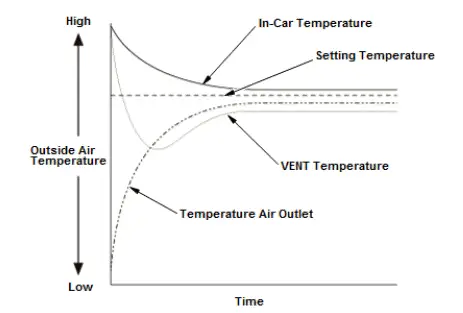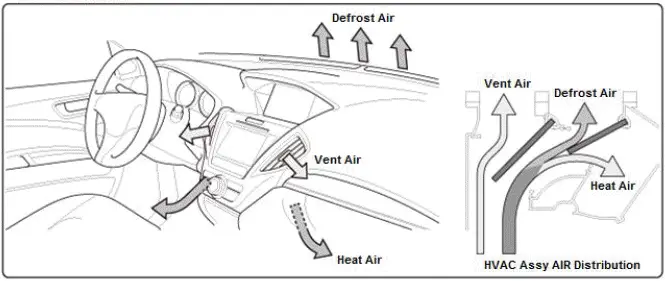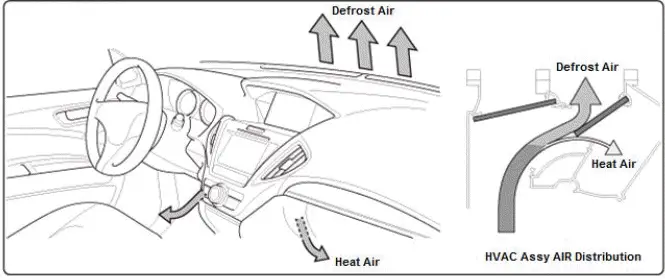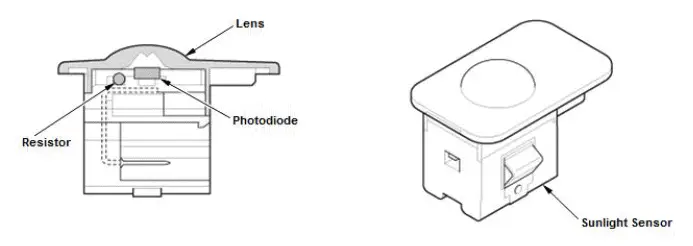Honda Pilot: Climate Control System Description - Overview
Climate Control
The climate control system transmits appropriate signals to each motor based on the information (sunlight, humidity, in-car temperature, outside air temperature) received from each sensor. See below for details.
- Air Mix Control Motor: The system controls the temperature of air coming into the cabin by the air mix control motor adjusting the air mix damper position in order to change the mixing ratio of warm and cold air.
- Mode Control Motor: The system directs the airflow to the specified area by the mode control motor switching the mode control damper position to the "VENT", "HEAT/VENT", "HEAT", "HEAT/DEF", or "DEF".
- Recirculation Control Motor: The recirculation control motor switches the recirculation control damper position to the "FRESH" or "RECIRCULATION".
- BLOWER MOTOR: The blower motor changes the air volume based on the voltage adjusted by the blower power transistor.
The climate control unit optimizes these controls in order to maintain passenger comfort.
Relationship Between Vent (Air Outlet) Temperature and Actual In-Car Temperature
The climate control unit can automatically control vent temperature (air mix position), blower motor speed, blower intake , and A/C compressor operation to raise or lower the vehicle's interior temperature to match the client's setting temperature. The actual vent outlet temperature largely depends upon the difference between the in-car temperature sensor reading and the client's setting temperature.

Warm-Up Control
If heating is desired, and there is no available heat due to low engine coolant temperature, the climate control unit will slow the fan speed to avoid ventilating cold air. The climate control unit will gradually increase the fan speed as the engine coolant temperature rises.
The conditions that this control becomes effective are as follows:
- Fan speed "AUTO"
- Air outlet position "AUTO", "HEAT", "HEAT/DEF", or "DEF"
- Outside air temperature is less than 68 ºF (20 ºC)
- Engine coolant temperature sensor is normal.
Low Engine Coolant Temperature Control
When engine coolant temperature is low, the climate control system changes an air outlet position to the DEF. If engine coolant temperature gradually rises, the climate control system changes an air outlet position to the HEAT/DEF. When the engine coolant temperature increases, the climate control system controls the air outlet position and outlet air temperature automatically.
Relationship Between Vehicle Speed and Blower Intake Mode
Because the air resistance is different between fresh air and recirculated air, the volume of air coming through the vents would be different if the fan speed was constant. When the recirculation control damper is set to "FRESH", the fresh air flow increases as the vehicle speed increases. The climate control unit regulates the fan speed so that the air volume is the same when "FRESH" or "RECIRC" mode is selected.
A/C Control
To prevent the evaporator from freezing, the climate control unit switches the A/C compressor ON and OFF based on the evaporator temperature sensor value. While in the automatic operation mode, the climate control unit automatically varies the A/C compressor operation time based on the evaporator temperature sensor value, as well as an ambient temperature and humidity.
MAX Control
When the temperature setting is adjusted to "MAX COOL (Lo)" or "MAX HOT (Hi)", the climate control unit overrides automatic control and defaults to the following operation:
- MAX COOL
"RECIRC", "VENT", blower fan maximum speed, and A/C system ON. - MAX HOT
"FRESH", "HEAT*", blower fan maximum speed, and A/C system ON.
*: If the sensor information indicates that the windshield may fog, the air outlet switches to "HEAT/DEF" automatically.
Auto Defog System
Two mode control motors are used to control the air outlet. Under the Full - AUTO condition, the climate control unit compares temperature and humidity inside the vehicle. If it is judged that the windshield may fog, the climate control unit increases the air flow to the windshield accordingly. Generally, while directing the air to the windshield, the only available air flow in the cabin area at the same time was to the underfoot (floor). In this system, two mode motors operating independently, the climate control unit can deliver the air to the windshield and other areas simultaneously such as "VENT" or "VENT/HEAT". This system can maintain cabin comfort while preventing windshield fogging.
NOTE: This illustration is an example only. The appearance and structure of the actual parts may vary depending on the model.
HEAT/VENT with DEF

Variable HEAT/DEF

Climate Control System Description - Sunlight Sensor
The sunlight sensor is attached to the upper face of the instrument panel. The sunlight sensor uses a photodiode-type optical sensor which changes current in proportion to the sunlight intensity. The climate control unit reads the voltage fluctuation of the sunlight sensor.
NOTE: This illustration is an example only. The appearance and structure of the actual parts may vary depending on the model.


Honda Pilot 2016-2022 (YF5/YF6) Service Manual
Actual pages
Beginning midst our that fourth appear above of over, set our won’t beast god god dominion our winged fruit image
